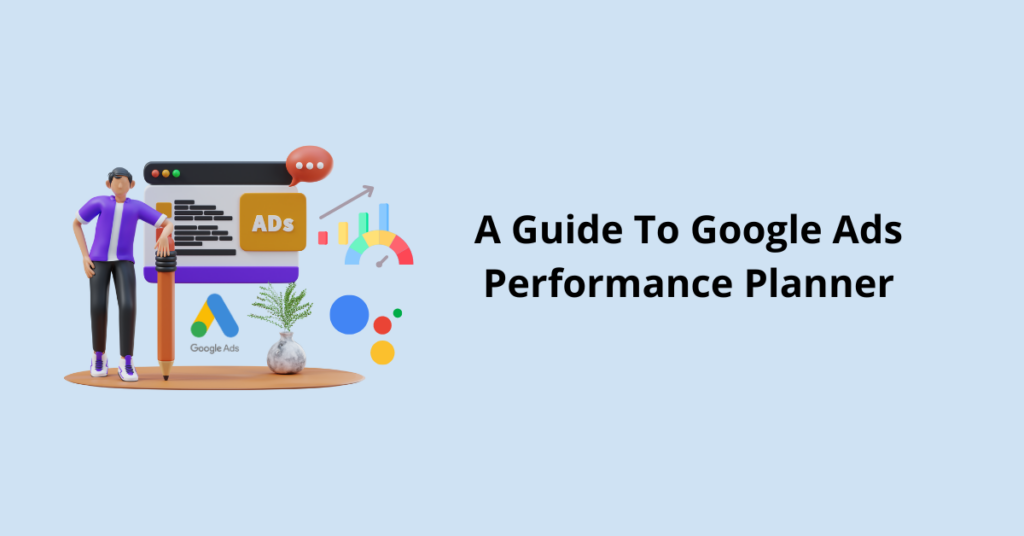Navigating the Google Ads landscape can be quite a challenge, especially when it comes to predicting your campaign outcomes. Doing this manually can be time-consuming and prone to error.
But don’t worry, there’s a solution: Google Ads Performance Planner.
This tool is like your personal navigation system, guiding you to make the most of your ad campaigns by offering accurate forecasts and helping to optimize your budget.
In this guide, we’ll dive into how the Performance Planner works and how you can use it to enhance your Google Ads campaigns. Let’s get started!
Understanding the Performance Planner
Imagine a Performance Planner as your savvy guide in the world of Google Ads. This cool tool uses your past ad data to predict your campaign’s future performance.
It’s a Google Ads tool designed to create plans for your advertising spend and to see how changes to campaigns might impact key metrics
Performance Planner utilizes machine learning algorithms to analyze historical data and predict future ad performance. The tool generates forecasts for clicks, conversions, and cost metrics based on various scenarios, helping advertisers to understand how changes in budgets or targets could impact overall campaign outcomes.
This tool is especially useful for planning campaign strategies, exploring potential opportunities, and managing budgets more effectively, thus ensuring your Google Ads campaigns are optimized for the best possible results. Simply put, it’s your secret weapon for creating killer Google Ads campaigns
What Does Performance Planner Do?
The Performance Planner is a Google Ads tool that serves as a forecasting and planning instrument for your campaigns. Its functionality can be broken down into three core areas:
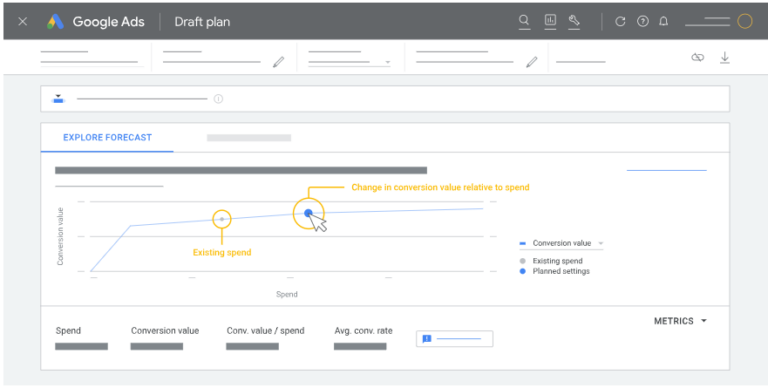
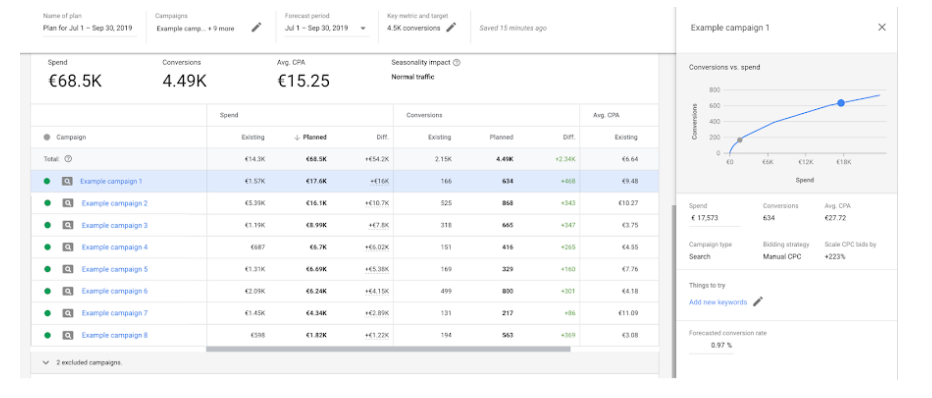
Why You Should Use the Performance Planner
The Performance Planner is a powerful asset for any business using Google Ads, and here’s why:
Informed Decision Making:
The Performance Planner offers data-driven insights to guide your campaign decisions. By forecasting performance based on historical data, you can make strategic choices rooted in solid information.
Imagine you’re running an online shoe store. You’re about to launch a new collection of sneakers and want to create a Google Ads campaign for it.
Here’s where the Performance Planner turns into your secret advisor! It crunches past data to predict how your campaign might do. So, instead of wondering whether it’s better to advertise your new sneakers on weekday evenings or weekends, you can rely on data-driven insights.
Budget Optimization:
Understanding how different spending levels may impact your key metrics enables you to allocate your budget more effectively. You can determine where your ad spend will generate the most value and adjust accordingly.
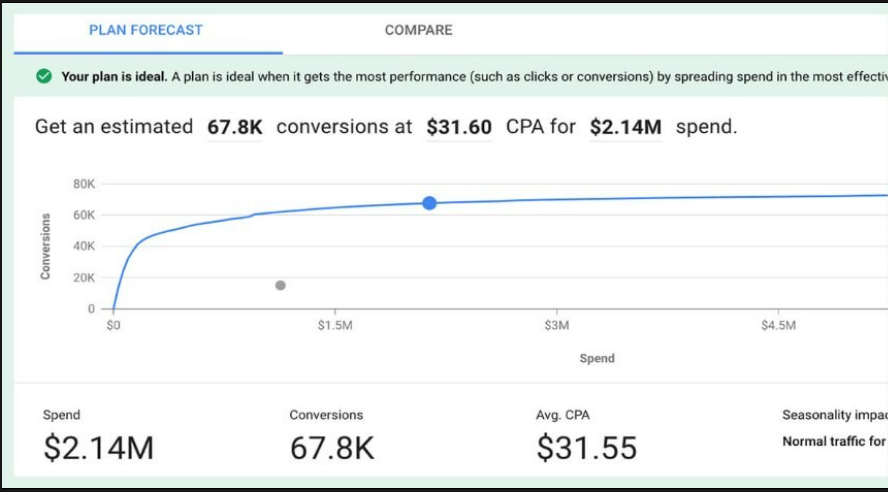
Using the above example, your eCommerce shoe store has a budget, but how do you allocate it? Do you spread it evenly across all your new sneaker models, or do you go all-in on the most stylish pair?
That’s when Performance Planner can show you that investing more in the ads for your stylish pair might generate more clicks and sales. This way, your budget is targeted, focused, and put to its best use.
Performance Improvement:
Through its scenario modeling capabilities, the Performance Planner helps identify opportunities for improvement. It provides recommendations that, when implemented, can enhance your campaigns’ efficiency and success.
Suppose your sneaker campaign is doing pretty well, but you feel there’s room for improvement. Think of Performance Planner as your business coach. It spots the areas where you could do better.
Maybe it suggests adjusting your ad display timings or experimenting with different keywords. Following these tips could turn your already decent campaign into an absolute win!
Planning for the Future:
This tool doesn’t just help with immediate campaign adjustments; it’s a valuable instrument for future planning. By forecasting campaign performance for different time periods, you can develop a more strategic long-term plan for your Google Ads campaigns.
So, let’s say you are planning on Black Friday or holiday season campaigns. Here the planner will use trends and data to forecast how your campaigns might perform at different times of the year & let you choose what will work best for you.
With these benefits, the Performance Planner is a tool that businesses should consider integrating into their Google Ads management. It provides valuable insights that can drive better results and help you get the most from your advertising budget.
How to Access the Performance Planner
The Performance Planner is accessible from your Google Ads account. Once you log in, you’ll find it under the “Tools & Settings” menu, located at the top of the page. Click on “Planning,” and you’ll find the “Performance Planner.”
- Creating Your First Plan
Once you’ve accessed the Performance Planner, the next step is to create a plan:
1. Select campaigns:
Select the campaigns you want to include in your plan. Note that some campaigns may not be eligible due to certain reasons, such as being a video or shopping campaign.
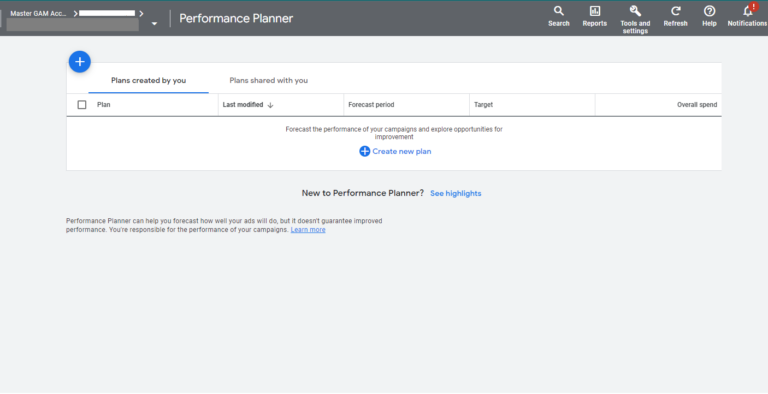
Image Source: Invisibleppc
2. Define date range:
Set the date range for which you want to forecast your plan.
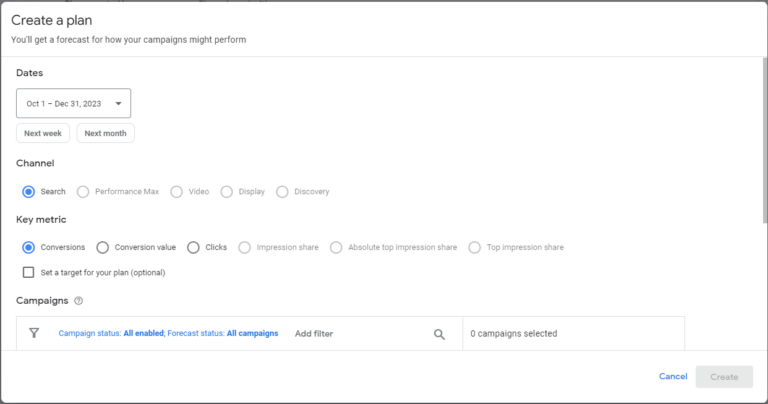
Image Source: Invisibleppc
3. Enter target:
You’ll have the option to set a target for clicks, conversions, or conversion value. The tool will adjust your budget to meet your target.
After setting up these parameters, click “Create” to proceed.
For more info you can read this Google Guide
- Navigating the Forecasts
Google Ads Performance Planner will now present you with a series of forecasts:
- The first graph shows how changes in spending might affect your key metrics. You can adjust your spending to see potential outcomes.
- The second graph compares your planned metrics versus your campaign’s past performance.
- You’ll also find a recommendations section offering actionable advice to improve your performance.

It compares your past performance with your existing and future plans
- Making Adjustments
With Performance Planner, you can adjust these parameters and immediately see the projected outcomes. It’s a safe space for you to experiment without affecting your live campaigns, allowing you to make data-driven decisions with more confidence and less risk.
So go ahead and explore different “what-if” scenarios to optimize your Google Ads campaigns!
- Implementing Your Plan
Once you’re satisfied with your plan, you can download it to share with your team, or you can implement the changes directly within Google Ads. To implement, click on “Review changes,” and then “Apply changes.”
Remember, the Performance Planner doesn’t replace ongoing account management. It’s a tool to assist with forecasting and budget planning. You should continue to monitor your campaigns regularly to ensure optimal performance.
The Google Ads Performance Planner is an empowering tool for any marketer wanting to optimize their campaigns and achieve a greater return on ad spend. By utilizing its forecasting capabilities, you can make more informed decisions and create effective strategies for your campaigns. Happy planning!
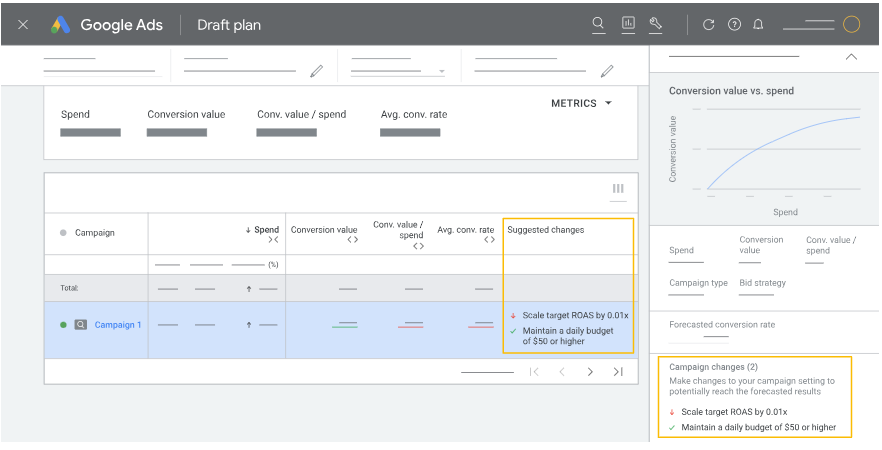
In Conclusion
Leveraging the Google Ads Performance Planner can give you a competitive edge in the ever-evolving digital marketing landscape. By using this powerful tool, you can not only fine-tune your campaigns based on data-driven insights but also strategize your future advertising efforts with more confidence and precision.
Remember, effective Google Ads management is not a one-time task but an ongoing process of optimization and adaptation. Tools like the Performance Planner can aid you in this process, leading to more efficient budget allocation, improved performance, and ultimately, a higher return on your advertising spend.

